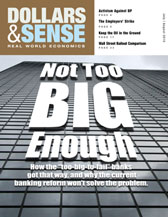This article is from the July/August 2010 issue of Dollars & Sense: Real World Economics, available at http://www.dollarsandsense.org

This article is from the July/August 2010 issue of Dollars & Sense magazine.
Subscribe Now
at a 30% discount.

Employers Go on Strike—Because They Can
The Journal editors support bosses’ strike demands.
Employers on Strike
Congress keeps giving business reasons not to hire.
Yesterday [June 4th] Americans learned that the economy created a net total of 431,000 new jobs in May, including 411,000 temporary Census hires. The private economy-that is, the wealth creation part, not the wealth redistribution part-gained only 41,000 jobs, down sharply from the encouraging 218,000 in April, and 158,000 in March.
Almost everything Congress has done in recent months has made private businesses less inclined to hire new workers. ObamaCare imposes new taxes and mandates on private employers. Even with record unemployment, Congress raised the minimum wage to $7.25, pricing more workers out of jobs.
The “jobs” bill that the House passed last week expands jobless insurance to 99 weeks, while raising taxes by $80 billion on small employers and U.S-based corporations. On January 1, Congress is set to let taxes rise on capital gains, dividends and small businesses.
—Wall Street Journal, “Review & Outlook,” June 5, 2010
Employers surely have been on strike, but that’s hardly news. Private sector hiring through the first four months of 2010 was no higher than in 2009. What there has been for job growth in the private sector is due to the decline in layoffs (and discharges) not an uptick in hiring. As of May nearly eight million fewer workers were on private payrolls than when the recession began in Dec. 2007.
Employers may be on strike, but they haven’t missed a paycheck. The same, of course, can’t be said for the 17.8 million workers the striking employers failed to hire. That number includes the 15 million officially counted as unemployed, and another 2.8 million workers who gave up looking for work or who could never get their first job during the recession. And honoring the demands issued by the Wall Street Journal editors would not help find them a job but rather would prolong the employers’ strike.
Record Long-Term Unemployment
Unemployed workers have gone longer without a paycheck than any time in the last 62 years. In May the median or typical unemployment spell was 23.2 weeks (5.4 months). And 6.8 million workers, some 46% of the unemployed, had been unemployed over six months, the highest level of long-term unemployment on record (with data back to 1948). Even in the worst months of the early 1980s recession, when the jobless rate topped 10% for ten straight months, only one in four of the unemployed was out of work for more than six months.
Unemployed black workers, manufacturing workers, and workers in the transportation, utilities, financial, and information industries have all typically endured spells of unemployment 26 weeks or longer. In addition, the median unemployment spell increases unrelentingly with age, exceeding a half year for workers 35 or older and reaching 50 weeks, or nearly a year, for workers 65 and over.
The effects have been devastating. Just under one half of the unemployed have now gone without work longer than the traditional length of unemployment benefits (26 weeks). A third of the unemployed have gone a year or longer without a job. Congress has extended jobless benefits to a maximum of 99 weeks in states with high unemployment. Still the longer people are unemployed the more likely they are to eventually give up searching and drop out of the labor force.
There are few signs that unemployment will abate or its duration shorten, or that private sector hiring will spring back to life, anytime soon. In May 2010, there were still 5.5 officially unemployed workers for every job opening counted by the Bureau of Labor Statistics. With a backlog of 2.8 million workers wanting a job not accounted for in those figures, the official unemployment rate is likely to hover at near double-digits levels for the rest of 2010. In addition, with plenty of part-time employees who want full-time jobs, far more than during previous recoveries, employers will continue to add to those workers’ hours before they hire additional workers.
Employers’ Strike Demands
Employment readings admittedly vary month to month in any recovery, but the evidence is overwhelming: the private sector is not hiring.
Why not? The Wall Street Journal editors are only too happy to tell you: That pesky public sector keeps redistributing wealth, crushing whatever incentive employers might have had to hire workers. Health care mandates and taxes, a higher minimum wage, expanded jobless benefits, and, worst of all, the prospect of letting the Bush tax cuts expire.
The problems with the editors’ list of strike demands are manifold. First, each and every one of these demands would redistribute wealth, the editors’ supposed complaint about the public sector. But in this case that redistribution would favor employers, not workers. Not providing health care benefits, allowing the purchasing power of the minimum wage to deteriorate, skimping on social spending, cutting taxes on capital gains and dividends, and lowering the top income-tax bracket have all contributed to a massive redistribution of income to the wealthy over the last three decades, a trend the editors are dedicated to continuing.
Second, employers already have the financial wherewithal to hire new workers. Their costs are down, their profits are up, and they are rolling in dough. Corporate profits are back to pre-recession levels. The combination of rapid productivity gains and stagnant wages have slashed unit labor costs (compensation costs per unit of output) to lower levels than before the onset of the recession. And by the end of March 2010, non-financial corporations held 7% of all their assets in cash, the highest level since 1963.
Third, government spending is the source of much of what there has been in the way of new jobs. As the editors point out, almost all the jobs created in May 2010 were temporary Census hires. In addition, according to estimates from the Congressional Budget Office, the $895 billion government stimulus passed in early 2009 created jobs for between 1.2 million and 2.8 million workers during the first quarter of 2010. Even the lower estimate exceeds the 1.15 million hires in the private sector in the same time period, some of which should be directly attributed to the stimulus package.
No Restart Button
Finally and most importantly, the policies the editors attack are not what stand between us and massive hiring and sustained economic growth. Undoing those policies, as limited as they have been, and re-instituting the Bush tax cuts, would constitute little more than hitting the restart button. And what would be restarted is nothing other than the very forces that brought on the worst crisis since the Great Depression.
Consider this: The economy has grown only about half as quickly as typically follows a deep recession. Much of the reason has been sputtering consumer spending, held back by a lack of jobs, to be sure, and by the debt consumers racked up during the last two decades. The very polices advocated by the editors kept a lid on wages and concentrated income gains among those at the top, leaving most consumers to ring up more and more debt in an effort to keep up their standard of living. That debt burden, still a third higher than that in the mid 1990s relative to household income, continues to hamstring consumption. A recent Gallup Poll reveals that the modest increase in consumer spending over the last year came exclusively from well-to-do families. Consumers with an income over $90,000 a year increased their monthly expenditures by one-third from May 2009 to May 2010, while the monthly expenditures of consumers with incomes below $90,000 remained unchanged.
More government spending is needed to help jump-start the engine of economic growth. A good place to start is the Local Jobs for America Act of 2010, introduced by Rep. George Miller (D-Cal.). It would create or save approximately 1 million jobs by protecting or creating state and local government and nonprofit sector jobs. Those jobs are much needed since state and local governments have shed 231,000 jobs since August 2008.
But the engine of economic growth needs to be rebuilt as well. Employers are not the only ones on strike; lenders are as well. In 2009 total outstanding loans at FDIC insured banks dropped an epic 7.4%, the sharpest decline in lending since 1942. Without genuine reform that breaks the power of the mega-financial institutions, protects consumers and mortgage holders, and regulates financial transactions, lending will not resume. And what there is for economic growth will reward the employers the editors are so concerned about, while the jobs machine sputters and workers continue to endure long spells of unemployment.
Did you find this article useful? Please consider supporting our work by donating or subscribing.

